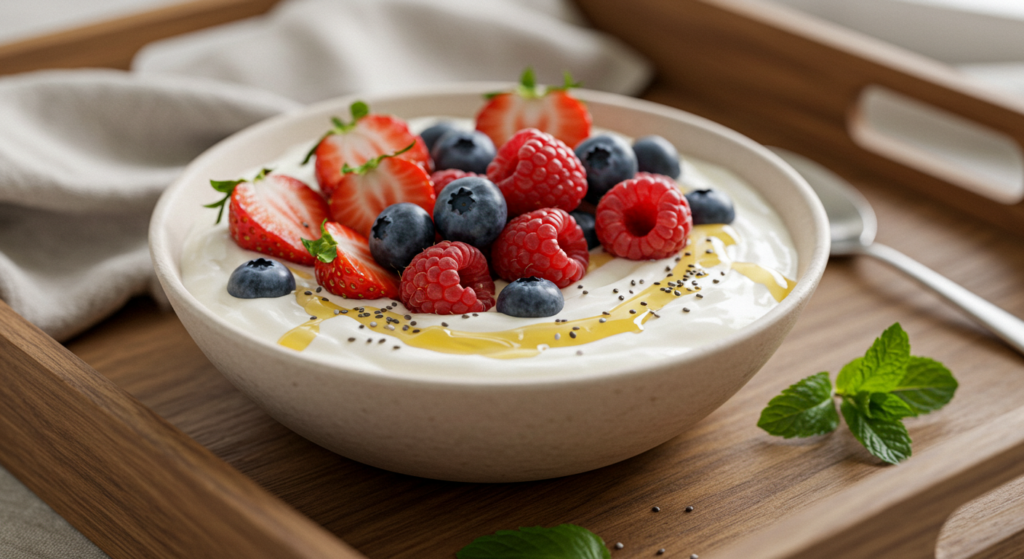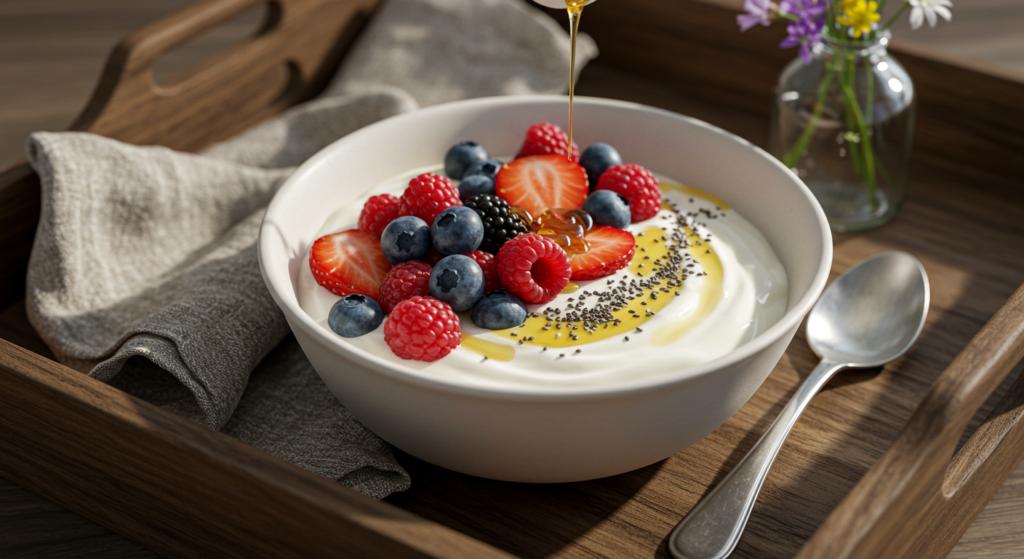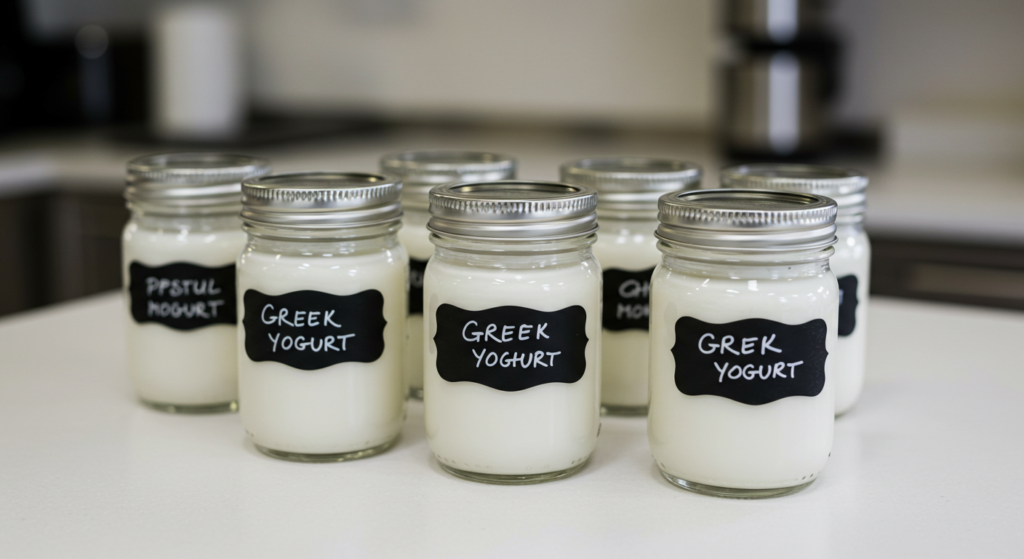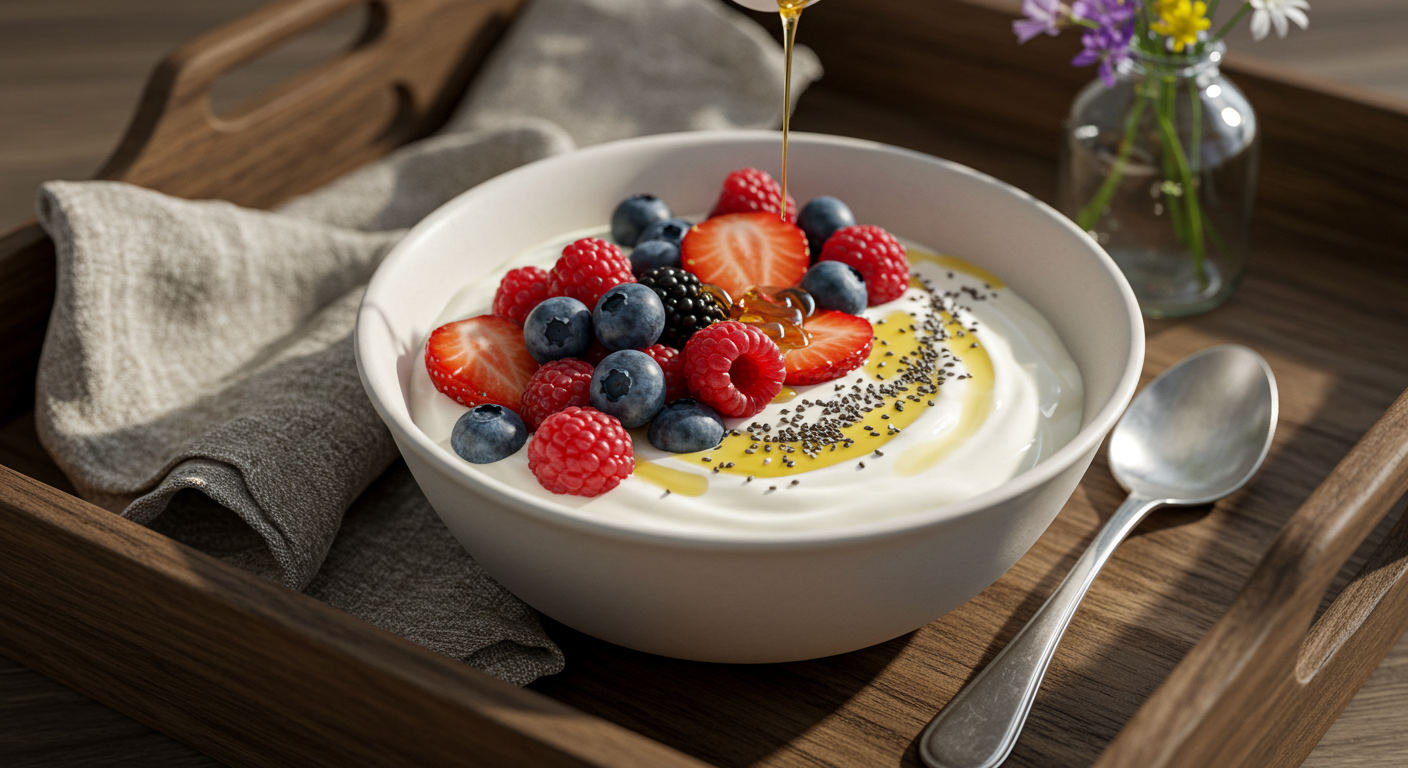If you love starting your day with a creamy, satisfying bowl of yogurt—but want to skip the added sugars, preservatives, and artificial flavors—then this is the Greek yogurt recipe for you.
Making Greek yogurt at home may sound complicated, but it’s actually simple, affordable, and incredibly rewarding. With just two basic ingredients and a little patience, you can whip up a rich, thick yogurt that’s healthier than most store-bought brands—and packed with live probiotics that support gut health and digestion.
Whether you’re following a high-protein diet, looking to cut down on processed foods, or just want to know exactly what’s in your breakfast, homemade Greek yogurt is the perfect solution. It’s naturally low in carbs, high in protein, and full of healthy fats, making it a great fit for clean eating and balanced meal prep.
In this step-by-step guide, you’ll learn:
- How to make your yogurt using just milk and a yogurt starter
- Pro tips to achieve that signature thick and tangy texture
- Flavor variations, toppings, and ways to enjoy your yogurt every day
So if you’re ready to take control of your ingredients, save money, and enjoy a delicious homemade treat that’s creamy, healthy, and totally customizable, you’re going to love what’s ahead.
Let’s dive into the ultimate Greek yogurt recipe and turn your kitchen into a yogurt-making haven!
Why Make Greek Yogurt at Home?
Healthier Than Store-Bought Options
Choosing to follow a Greek yogurt recipe at home gives you more than just a creamy texture—it gives you peace of mind. Unlike many store-bought options that may contain added sugar, thickeners, or artificial flavors, homemade Greek yogurt is simple, natural, and full of health benefits.
Fewer Ingredients, More Nutrition
When you make yogurt yourself, you know exactly what’s going into it. Most store-bought yogurts include unnecessary extras like preservatives, sweeteners, and stabilizers. Even brands that look healthy on the label can be surprisingly high in sugar.
In contrast, a homemade yogurt recipe uses just two ingredients—milk and a yogurt starter. That’s it. No hidden additives, no filler ingredients—just clean, nourishing food made in your kitchen. This allows the probiotics to flourish naturally, giving your gut the support it needs without extra junk.
Better for Your Gut and Your Goals
Many people turn to yogurt for its probiotic content, but not all store-bought versions are created equal. Some are pasteurized after fermentation, which kills off the live cultures. Others barely contain any beneficial bacteria at all.
With a homemade Greek yogurt recipe, you control the fermentation time, which directly impacts the strength of those gut-friendly probiotics. The result? A yogurt that supports digestion, reduces bloating, and contributes to a stronger immune system.
Plus, since it’s higher in protein and lower in carbs—especially when strained into thick Greek-style yogurt—it fits seamlessly into low-carb, keto, or clean eating plans. It’s a truly healthy yogurt alternative that supports your body and tastes even better.
Budget-Friendly and Customizable
One of the best parts about following a Greek yogurt recipe at home is that it’s not only healthier, but it’s also surprisingly affordable. Store-bought yogurt, especially the thick Greek varieties, can cost quite a bit, especially if you go through it quickly. But when you make your homemade yogurt, the savings really add up.
Save Money with Every Batch
A single container of high-quality Greek yogurt from the store can cost three to four times more than the same amount made at home. By using just milk and a yogurt starter, you can create large batches of creamy yogurt for a fraction of the price.
Plus, if you reserve a few spoonfuls from each batch to use as your next starter, your cost goes down even more over time. It’s a cost-effective, low-waste option that’s perfect for families, meal-preppers, or anyone who enjoys yogurt regularly.
Here’s how homemade yogurt saves money:
- Use bulk or store-brand milk for large batches
- Skip premium brands and additives
- Make multiple servings for the cost of one
Make It Your Own—Your Way
Beyond saving money, a homemade Greek yogurt recipe gives you complete freedom to tailor it to your taste. Want it thicker? Strain it longer. Prefer it mild? Ferment for less time. Need a dairy-free version? Try it with coconut or almond milk and an adjusted starter.
From texture to flavor, the custom options are endless:
- Choose your preferred milk: whole, 2%, or lactose-free
- Add honey, vanilla, or spices after fermentation
- Mix in fruit or natural sweeteners before serving
When you make your own, you’re no longer limited to what’s on store shelves. Instead, you get a yogurt that matches your diet, preferences, and nutrition goals—every time.
Ingredients & Tools You’ll Need

Basic Ingredients for Perfect Yogurt
One of the best things about making your Greek yogurt recipe is how simple the ingredient list really is. You don’t need anything fancy—just a few core items that work together to create that creamy, tangy texture we all love. By starting with quality ingredients, your homemade yogurt will taste better and be more consistent every time.
Start with the Right Milk
The foundation of any good homemade yogurt recipe is milk. You can use whole milk, 2%, or even lactose-free, depending on your dietary needs. However, for the creamiest results and that classic Greek-style richness, whole milk is your best bet.
Whole milk produces a thicker, silkier yogurt with a naturally sweet flavor, making it ideal for first-timers and yogurt lovers alike. If you’re aiming for a low-fat yogurt, 2% still works well, though the final texture will be slightly thinner.
Milk options that work well:
- Whole milk – best for creamy, rich yogurt
- 2% or skim milk – lighter, but still effective
- Lactose-free milk – great for sensitive stomachs
- Non-dairy (coconut, almond, etc.) – possible, but requires a special starter
The Power of a Good Starter
Once you’ve chosen your milk, the next essential ingredient is your yogurt starter—this is what introduces the live, active cultures that make fermentation possible. A plain, unsweetened yogurt with live and active cultures is ideal for your first batch. After that, you can save a spoonful of your homemade yogurt to use as the starter for the next one.
This simple step ensures that your easy yogurt recipe is full of gut-healthy probiotics and helps give your yogurt that distinct tang and smooth consistency.
Tips for the best starter:
- Look for “live and active cultures” on the label
- Avoid flavored or sweetened yogurts as starters
- Use about 2–3 tablespoons of yogurt per quart of milk
With just two ingredients—milk and starter—you’re already on your way to making thick, creamy, probiotic-rich Greek yogurt at home. It’s natural, cost-effective, and surprisingly simple.
Optional Add-Ins for Extra Flavor
One of the best parts of making your Greek yogurt recipe is that you get to decide exactly how it tastes. While the base homemade yogurt is creamy and mildly tangy on its own, adding a few simple ingredients can take it to the next level. Whether you prefer sweet, fruity, or even savory flavors, the options are endless—and fully customizable to your taste.
Sweet & Natural Flavor Boosts
If you enjoy a slightly sweeter yogurt, you don’t have to reach for artificial flavors or sugar-laden fruit blends. With a few natural add-ins, you can enhance the flavor while still keeping your yogurt clean and healthy.
Try stirring in:
- A drizzle of honey or maple syrup for subtle sweetness
- A splash of vanilla extract for a dessert-like aroma
- A sprinkle of cinnamon or nutmeg for warmth and depth
These ingredients blend beautifully with the thick texture of your homemade Greek yogurt, making it feel more like a treat than a healthy snack.
Fresh Additions for Variety and Nutrition
If you’re looking to switch things up or add more nutritional value, fresh fruits and nutrient-rich extras are great choices. They add flavor, color, texture, and fiber.
Consider:
- Sliced berries or bananas for a fruity twist
- A spoonful of chia seeds or flaxseeds for healthy fats
- A pinch of lemon zest to brighten the flavor naturally
You can mix these in right before eating or portion out a few different combinations for your weekly meal prep. It’s a simple way to turn your easy Greek yogurt recipe into something new and exciting each day.
Step-by-Step Greek Yogurt Recipe

Heat and Cool the Milk
One of the most important steps in any Greek yogurt recipe is heating and cooling the milk properly. This process sets the foundation for smooth texture, safe fermentation, and the tangy flavor we associate with homemade yogurt. It might sound technical, but once you understand the why and how, it’s a breeze to do.
Heating Helps Eliminate Unwanted Bacteria
Before you introduce your yogurt starter, you need to warm the milk to about 180°F (82°C). This step kills off any potentially harmful bacteria and helps the milk proteins change in a way that supports thickening later on. Don’t rush this part—slow, even heating is key.
You can do this on the stovetop using a heavy-bottomed pot. Gently stir the milk now and then to prevent scorching, and use a kitchen thermometer for accuracy. Once it hits the right temperature, please remove it from the heat immediately.
Cooling Prepares It for the Starter
After heating, the milk must cool down to around 110°F (43°C) before you add your yogurt starter. If it’s too hot, it can destroy the live cultures. If it’s too cold, the fermentation process may not activate properly.
Let the milk cool naturally at room temperature, or place the pot in an ice bath if you’re short on time. Stir occasionally to release heat evenly, and check the temperature with your thermometer before moving on. This ensures your easy yogurt recipe starts with the perfect environment for culturing. This simple step—heating and cooling the milk correctly—is the backbone of every reliable homemade Greek yogurt recipe. Once mastered, it becomes second nature and sets you up for delicious, consistent results every time.
Add Starter and Ferment
Once your milk has cooled to the right temperature, it’s time for the most important part of the Greek yogurt recipe—adding the starter and beginning the fermentation process. This is where your milk transforms into rich, tangy, homemade yogurt.
Mix in the Yogurt Starter Gently
Your starter is what brings your yogurt to life—literally. It contains the live, active cultures that ferment the milk and create that creamy, probiotic-rich consistency we love. To begin, add about 2 to 3 tablespoons of plain yogurt with live cultures per quart of milk.
Stir the starter into the cooled milk gently. Avoid overmixing or whisking too hard, as that can break down the milk proteins and lead to a thinner final product. A calm, smooth stir ensures even distribution without disrupting the texture.
If this is your first batch, use a store-bought plain yogurt labeled with “live and active cultures.” For future batches, you can use a few spoonfuls from your own homemade Greek yogurt as your starter.
Let the Fermentation Work Its Magic
After the starter is mixed in, it’s time to let nature take over. Pour the milk mixture into a clean glass or ceramic container, cover it, and place it somewhere warm and draft-free. The goal is to keep the yogurt at a steady 100–110°F (38–43°C) for the next 6 to 12 hours.
You can use several methods to keep the mixture warm:
- Leave the container in an oven with the light on
- Use a yogurt maker or Instant Pot with a yogurt setting
- Wrap it in a towel and place it in a turned-off oven or an insulated cooler
The longer the fermentation, the tangier your yogurt will taste. If you prefer a milder flavor, aim for the 6–8 hour range. For a bolder, more tangy yogurt, let it sit closer to 10–12 hours.
Strain and Store

After your yogurt has finished fermenting, you’re just one final step away from enjoying thick, creamy Greek yogurt at home. What sets Greek-style yogurt apart from regular yogurt is this next part: straining. Not only does it improve the texture, but it also concentrates the flavor and boosts the protein content.
Strain for That Classic Greek Creaminess
Straining removes the liquid whey from the yogurt, giving it that signature rich, velvety consistency. To do this, place a cheesecloth or clean kitchen towel over a fine mesh strainer. Set the strainer over a bowl to catch the liquid, then pour in your homemade yogurt.
Let it strain in the fridge for 2 to 4 hours, depending on how thick you like it:
- 2 hours = lightly thick, similar to store-bought
- 4 hours = thick and spreadable, like cream cheese
For ultra-thick Greek yogurt, strain it overnight. Just be sure to cover it loosely to keep it fresh.
Store It Right to Keep It Fresh
Once your yogurt has reached your desired thickness, transfer it to clean glass jars or airtight containers. Homemade yogurt should be stored in the fridge and enjoyed within 7 to 10 days.
If you plan on making more yogurt in the future, remember to set aside a few tablespoons from this batch to use as your starter culture for the next. This keeps your yogurt-making process going without needing store-bought versions again.
Here’s how to get the best shelf life from your strained yogurt:
- Use sterilized jars or containers
- Keep it tightly sealed to prevent moisture loss
- Label the date to track freshness
Tips, Variations & Serving Ideas
Pro Tips for the Creamiest Texture
Achieving that rich, velvety smoothness in your Greek yogurt recipe is easier than you might think—it just takes a little attention to detail at each stage of the process. Whether you’re making yogurt for the first time or perfecting your go-to homemade yogurt, a few simple adjustments can make all the difference in texture.
Start with the Right Ingredients and Temperature
The key to creamy Greek yogurt begins long before the straining step. Start by using high-quality whole milk, which naturally contains more fat and helps create that luxurious, thick texture. While 2% or skim milk can work, they often result in a thinner consistency unless you add extra straining time.
Equally important is heating your milk properly. Warming it to 180°F (82°C) and then allowing it to cool to about 110°F (43°C) sets the stage for perfect fermentation. These temperatures help the proteins in the milk unfold and bind in a way that supports structure and silkiness as the yogurt forms.
Timing, Straining, and Stirring Matter
The fermentation time and straining technique also play a big role in the final consistency of your homemade yogurt. Letting the yogurt ferment for a full 8 to 12 hours will give it more time to set, thicken, and develop a balanced tang. The longer it sits (within reason), the denser and richer it becomes.
Once fermented, be gentle when you transfer the yogurt to a strainer. Use cheesecloth or a fine mesh strainer and let gravity do the work—no squeezing or pressing. Rushing this step can result in a gritty or broken texture instead of that signature creaminess.
And finally, when your yogurt is ready to eat, stir it gently. Over-mixing can thin out the final product and break the delicate structure formed during fermentation.
Flavor Variations to Try
One of the best things about following your Greek yogurt recipe is the freedom to make it taste exactly how you like. Whether you prefer your yogurt sweet, fruity, or a little adventurous, there’s no shortage of ways to upgrade your homemade Greek yogurt into something special, without added sugars or artificial flavors.
Sweet and Fruity Favorites
If you enjoy your yogurt as a snack or breakfast, adding natural sweeteners and fruits is a great way to enhance the flavor while keeping things healthy.
Try these tasty combinations:
- Honey + vanilla extract – for a warm, creamy flavor
- Mixed berries + a pinch of cinnamon – sweet, fresh, and antioxidant-rich
- Chopped mango or pineapple + lime zest – a tropical twist
These additions pair beautifully with the thick texture of your flavored Greek yogurt, offering sweetness without overpowering the natural tang.
Savory and Unexpected Twists
Greek yogurt isn’t just for breakfast. Its thick, creamy consistency also makes it a great base for dips, dressings, and even savory side dishes.
Experiment with:
- Minced garlic, olive oil, and lemon juice – a perfect Mediterranean dip
- Cucumber and dill – for a quick tzatziki-style sauce
- Smoked paprika or chili flakes – for a spicy, protein-rich topping
These homemade yogurt variations are great for pairing with grilled meats, roasted veggies, or as spreads for wraps and bowls.
Making your own Greek yogurt at home is easier than it seems—and the results are worth it. With just two simple ingredients and a little patience, you can enjoy a thick, creamy, and protein-packed yogurt that tastes better than anything store-bought.
This Greek yogurt recipe gives you full control over what goes into your food. You can skip the added sugars, avoid preservatives, and customize every batch to match your taste and dietary needs. Whether you enjoy it sweet with honey and berries or savory with herbs and spices, this is one recipe you’ll come back to again and again.
So, the next time you reach for yogurt at the grocery store, consider making your own instead. It’s budget-friendly, gut-healthy, and surprisingly satisfying to create from scratch.
Now that you know how to make homemade Greek yogurt, it’s your turn—give it a try, enjoy the process, and don’t forget to make it your own.

